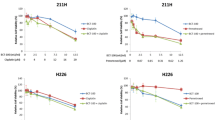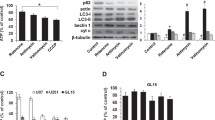Abstract
Over many years we have taken advantage of the special metabolism of cancer cells involving an increased consumption of glucose associated with lactic acid production even in the presence of oxygen, a phenomenon referred to as the “Warburg effect”, to counteract cancer cell growth. We have tested 3-bromopyruvate (3-BrPA), an inhibitor of pyruvate-associated reactions. Firstly, we tested this agent, in vitro, in two mesothelioma cell lines. Cellular response would appear to depend on the mode of administration (immediately or 24 h after seeding). Depending on the line, 3-BrPA induced a cytostatic or cytotoxic effect. This effect was accompanied by cell death induction even in cells highly refractory to cisplatin. Mitochondrial apoptotic death appeared to involve both lines; however, a different death pathway such as necrosis cannot be excluded. Interestingly, 3-BrPA leads to a diminution of the expression of the anti-apotptoic protein Mcl-1. We then tested 3-BrPA in vivo. Survival of nude mice bearing human mesothelioma was significantly prolonged (p < 0.0001). Toxicity and clinical studies should be performed to test 3- BrPA as local therapy for patients suffering from pleural or peritoneal mesothelioma. Association with cisplatin should be particularly considered.
Similar content being viewed by others
References
Baker JP, Rabin BR (1969) Effects of bromopyruvate on the control and catalytic properties of glutamate dehydrogenase. Eur J Biochem 11(1):154–159
Burz C, Berindan-Neagoe I, Balacescu O, Irimie A (2009) Apoptosis in cancer: key molecular signaling pathways and therapy targets. Acta Oncol 48(6):811–821
Cairns RA, Harris IS, Mak TW (2011) Regulation of cancer cell metabolism. Nat Rev Cancer 11(2):85–95
Campbell PN (2000) Biochemistry illustrated. Churchill Livingstone,
Carretta A, Landoni C, Melloni G, Ceresoli GL, Compierchio A, Fazio F et al (2000) 18-FDG positron emission tomography in the evaluation of malignant pleural diseases—a pilot study. Eur J Cardiothorac Surg 17(4):377–383
Chang GG, Hsu RY (1973) The substrate analog bromopyruvate as a substrate, an inhibitor and an alkylating agent of malic enzyme of pigeon liver. Biochem Biophys Res Commun 55(3):580–587
Christofk HR, Vander Heiden MG, Harris MH, Ramanathan A, Gerszten RE, Wei R et al (2008) The M2 splice isoform of pyruvate kinase is important for cancer metabolism and tumour growth. Nature 452(7184):230–233
Dang CV, Kim JW, Gao P, Yustein J (2008) The interplay between MYC and HIF in cancer. Nat Rev Cancer 8(1):51–56
Dang L, White DW, Gross S, Bennett BD, Bittinger MA, Driggers EM et al (2009) Cancer-associated IDH1 mutations produce 2-hydroxyglutarate. Nature 462(7274):739–744
Danial NN, Gramm CF, Scorrano L, Zhang CY, Krauss S, Ranger AM et al (2003) BAD and glucokinase reside in a mitochondrial complex that integrates glycolysis and apoptosis. Nature 424(6951):952–956
Deberardinis RJ, Cheng T (2010) Q’s next: the diverse functions of glutamine in metabolism, cell biology and cancer. Oncogene 29(3):313–324
Deberardinis RJ, Sayed N, Ditsworth D, Thompson CB (2008) Brick by brick: metabolism and tumor cell growth. Curr Opin Genet Dev 18(1):54–61
Eagle H, Oyama VI, Levy M, Horton CL, Fleischman R (1956) The growth response of mammalian cells in tissue culture to L-glutamine and L-glutamic acid. J Biol Chem 218(2):607–616
Ganapathy-Kanniappan S, Kunjithapatham R, Buijs M, Vossen JA, Tchernyshyov I, Cole RN et al (2009) Glyceraldehyde-3-phosphate dehydrogenase (GAPDH) is pyruvylated during 3-bromopyruvate mediated cancer cell death. Anticancer Res 29(12):4909–4918
Ganapathy-Kanniappan S, Vali M, Kunjithapatham R, Buijs M, Syed LH, Rao P et al (2010) 3-Bromopyruvate: a new targeted antiglycolytic agent and a promise for cancer therapy. Curr Pharm Biotechnol 11(5):510–517
Geschwind JF, Georgiades CS, Ko YH, Pedersen PL (2004) Recently elucidated energy catabolism pathways provide opportunities for novel treatments in hepatocellular carcinoma. Expert Rev Anticancer Ther 4(3):449–457
Green DR, Kroemer G (2004) The pathophysiology of mitochondrial cell death. Science 305(5684):626–629
Gruning NM, Lehrach H, Ralser M (2010) Regulatory crosstalk of the metabolic network. Trends Biochem Sci 35(4):220–227
Icard P, Poulain L, Lincet H (2012) Understanding the central role of citrate in the metabolism of cancer cells. Biochim Biophys Acta 1825(1):111–116
Ihrlund LS, Hernlund E, Khan O, Shoshan MC (2008) 3-bromopyruvate as inhibitor of tumour cell energy metabolism and chemopotentiator of platinum drugs. Mol Oncol 2(1):94–101
Israël M (2004) Four hidden metamorphoses: a remark on blood, muscle, mental diseases and cancer. John Libbey Eurotext
Israël M (2005) Cancer: a dysmethylation syndrome. John Libbey Eurotext
Kim JW, Tchernyshyov I, Semenza GL, Dang CV (2006) HIF-1-mediated expression of pyruvate dehydrogenase kinase: a metabolic switch required for cellular adaptation to hypoxia. Cell Metab 3(3):177–185
Ko YH, Pedersen PL, Geschwind JF (2001) Glucose catabolism in the rabbit VX2 tumor model for liver cancer: characterization and targeting hexokinase. Cancer Lett 173:83–91
Ko YH, Smith BL, Wang Y, Pomper MG, Rini DA, Torbenson MS et al (2004) Advanced cancers: eradication in all cases using 3-bromopyruvate therapy to deplete ATP. Biochem Biophys Res Commun 324(1):269–275
Koppenol WH, Bounds PL, Dang CV (2011) Otto Warburg’s contributions to current concepts of cancer metabolism. Nat Rev Cancer 11(5):325–337
Kroemer G, Pouyssegur J (2008) Tumor cell metabolism: cancer’s Achilles’ heel. Cancer Cell 13(6):472–482
Leist M, Single B, Castoldi AF, Kuhnle S, Nicotera P (1997) Intracellular adenosine triphosphate (ATP) concentration: a switch in the decision between apoptosis and necrosis. J Exp Med 185(8):1481–1486
Lelli JL Jr, Becks LL, Dabrowska MI, Hinshaw DB (1998) ATP converts necrosis to apoptosis in oxidant-injured endothelial cells. Free Radic Biol Med 25(6):694–702
Lincet H, Guével B, Pineau C, Allouche S, Lemoisson E, Poulain L, et al. (2011) Comparative 2D-DIGE proteomic analysis of ovarian carcinoma cells: Toward a reorientation of biosynthesis pathways associated with acquired platinum resistance. J Proteomics, [Epub ahead of print]
Lopez-Rios F, Sanchez-Arago M, Garcia-Garcia E, Ortega AD, Berrendero JR, Pozo-Rodriguez F et al (2007) Loss of the mitochondrial bioenergetic capacity underlies the glucose avidity of carcinomas. Cancer Res 67(19):9013–9017
Marin-Hernandez A, Gallardo-Perez JC, Ralph SJ, Rodriguez-Enriquez S, Moreno-Sanchez R (2009) HIF-1alpha modulates energy metabolism in cancer cells by inducing over-expression of specific glycolytic isoforms. Mini Rev Med Chem 9(9):1084–1101
Mazurek S (2003) The tumor metabolome. Anticancer Res 23:1149–1154
Mazurek S (2011) Pyruvate kinase type M2: a key regulator of the metabolic budget system in tumor cells. Int J Biochem Cell Biol 43(7):969–980
Olovnikov IA, Kravchenko JE, Chumakov PM (2009) Homeostatic functions of the p53 tumor suppressor: regulation of energy metabolism and antioxidant defense. Semin Cancer Biol 19(1):32–41
Papandreou I, Goliasova T, Denko NC (2011) Anticancer drugs that target metabolism: is dichloroacetate the new paradigm? Int J Cancer 128(5):1001–1008
Pastorino JG, Hoek JB (2008) Regulation of hexokinase binding to VDAC. J Bioenerg Biomembr 40(3):171–182
Pedersen PL, Mathupala S, Rempel A, Geschwind JF, Ko YH (2002) Mitochondrial bound type II hexokinase: a key player in the growth and survival of many cancers and an ideal prospect for therapeutic intervention. Biochim Biophys Acta 1555(1–3):14–20
Porporato PE, Dhup S, Dadhich RK, Copetti T, Sonveaux P (2011) Anticancer targets in the glycolytic metabolism of tumors: a comprehensive review. Front Pharmacol, 2(49): doi:10.3389
Reitzer LJ, Wice BM, Kennell D (1979) Evidence that glutamine, not sugar, is the major energy source for cultured HeLa cells. J Biol Chem 254(8):2669–2676
Samudio I, Fiegl M, Andreeff M (2009) Mitochondrial uncoupling and the Warburg effect: molecular basis for the reprogramming of cancer cell metabolism. Cancer Res 69(6):2163–2166
Simonnet H, Demont J, Pfeiffer K, Guenaneche L, Bouvier R, Brandt U et al (2003) Mitochondrial complex I is deficient in renal oncocytomas. Carcinogenesis 24(9):1461–1466
Vander Heiden MG, Cantley LC, Thompson CB (2009) Understanding the Warburg effect: the metabolic requirements of cell proliferation. Science 324(5930):1029–1033
Varin E, Denoyelle C, Brotin E, Meryet-Figuiere M, Giffard F, Abeilard E et al (2010) Downregulation of Bcl-xL and Mcl-1 is sufficient to induce cell death in mesothelioma cells highly refractory to conventional chemotherapy. Carcinogenesis 31(6):984–993
Warburg O (1930) The metabolism of tumors. Constable & Co. Ltd, London
Warburg O (1956) On the origin of cancer cells. Science 123(3191):309–314
Warr MR, Shore GC (2008) Unique biology of Mcl-1: therapeutic opportunities in cancer. Curr Mol Med 8(2):138–147
Wellen KE, Hatzivassiliou G, Sachdeva UM, Bui TV, Cross JR, Thompson CB (2009) ATP-citrate lyase links cellular metabolism to histone acetylation. Science 324(5930):1076–1080
Willis SN, Chen L, Dewson G, Wei A, Naik E, Fletcher JI et al (2005) Proapoptotic Bak is sequestered by Mcl-1 and Bcl-xL, but not Bcl-2, until displaced by BH3-only proteins. Genes Dev 19(11):1294–1305
Xu RH, Pelicano H, Zhou Y, Carew JS, Feng L, Bhalla KN et al (2005) Inhibition of glycolysis in cancer cells: a novel strategy to overcome drug resistance associated with mitochondrial respiratory defect and hypoxia. Cancer Res 65(2):613–621
Yan H, Parsons DW, Jin G, McLendon R, Rasheed BA, Yuan W et al (2009) IDH1 and IDH2 mutations in gliomas. N Engl J Med 360(8):765–773
Yip KW, Reed JC (2008) Bcl-2 family proteins and cancer. Oncogene 27(50):6398–63406
Zhang X, Varin E, Allouche S, Lu Y, Poulain L, Icard P (2009a) Effect of citrate on malignant pleural mesothelioma cells: a synergistic effect with cisplatin. Anticancer Res 29(4):1249–1254
Zhang X, Varin E, Briand M, Allouche S, Heutte N, Schwartz L et al (2009b) Novel therapy for malignant pleural mesothelioma based on anti-energetic effect: an experimental study using 3-Bromopyruvate on nude mice. Anticancer Res 29(4):1443–1448
Author information
Authors and Affiliations
Corresponding author
Rights and permissions
About this article
Cite this article
Philippe, I., Xiao-Dong, Z., Edwige, L. et al. Experimental results using 3-bromopyruvate in mesothelioma: in vitro and in vivo studies. J Bioenerg Biomembr 44, 81–90 (2012). https://doi.org/10.1007/s10863-012-9415-6
Received:
Accepted:
Published:
Issue Date:
DOI: https://doi.org/10.1007/s10863-012-9415-6




